Fenglin Liu
Key Laboratory of Optoelectronic Technology and Systems, Ministry of Education, Chongqing University, Chongqing 400044, China
RiskAgent: Autonomous Medical AI Copilot for Generalist Risk Prediction
Mar 05, 2025Abstract:The application of Large Language Models (LLMs) to various clinical applications has attracted growing research attention. However, real-world clinical decision-making differs significantly from the standardized, exam-style scenarios commonly used in current efforts. In this paper, we present the RiskAgent system to perform a broad range of medical risk predictions, covering over 387 risk scenarios across diverse complex diseases, e.g., cardiovascular disease and cancer. RiskAgent is designed to collaborate with hundreds of clinical decision tools, i.e., risk calculators and scoring systems that are supported by evidence-based medicine. To evaluate our method, we have built the first benchmark MedRisk specialized for risk prediction, including 12,352 questions spanning 154 diseases, 86 symptoms, 50 specialties, and 24 organ systems. The results show that our RiskAgent, with 8 billion model parameters, achieves 76.33% accuracy, outperforming the most recent commercial LLMs, o1, o3-mini, and GPT-4.5, and doubling the 38.39% accuracy of GPT-4o. On rare diseases, e.g., Idiopathic Pulmonary Fibrosis (IPF), RiskAgent outperforms o1 and GPT-4.5 by 27.27% and 45.46% accuracy, respectively. Finally, we further conduct a generalization evaluation on an external evidence-based diagnosis benchmark and show that our RiskAgent achieves the best results. These encouraging results demonstrate the great potential of our solution for diverse diagnosis domains. To improve the adaptability of our model in different scenarios, we have built and open-sourced a family of models ranging from 1 billion to 70 billion parameters. Our code, data, and models are all available at https://github.com/AI-in-Health/RiskAgent.
MedVLM-R1: Incentivizing Medical Reasoning Capability of Vision-Language Models (VLMs) via Reinforcement Learning
Feb 26, 2025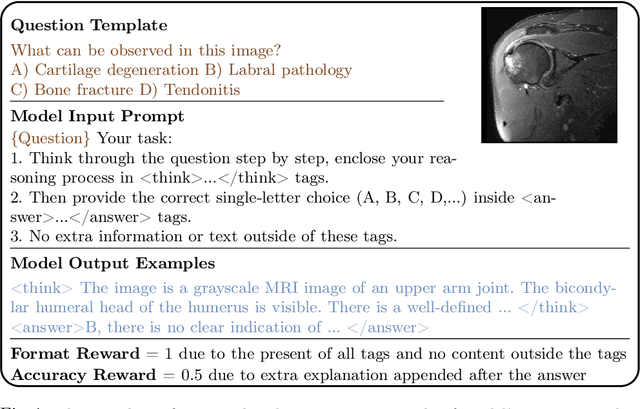
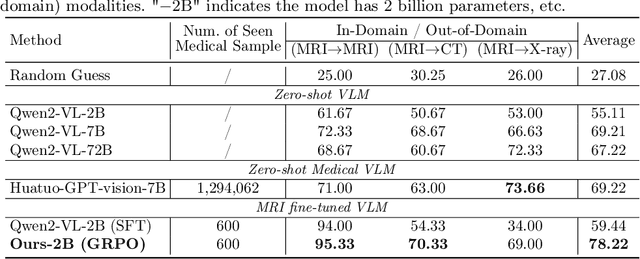
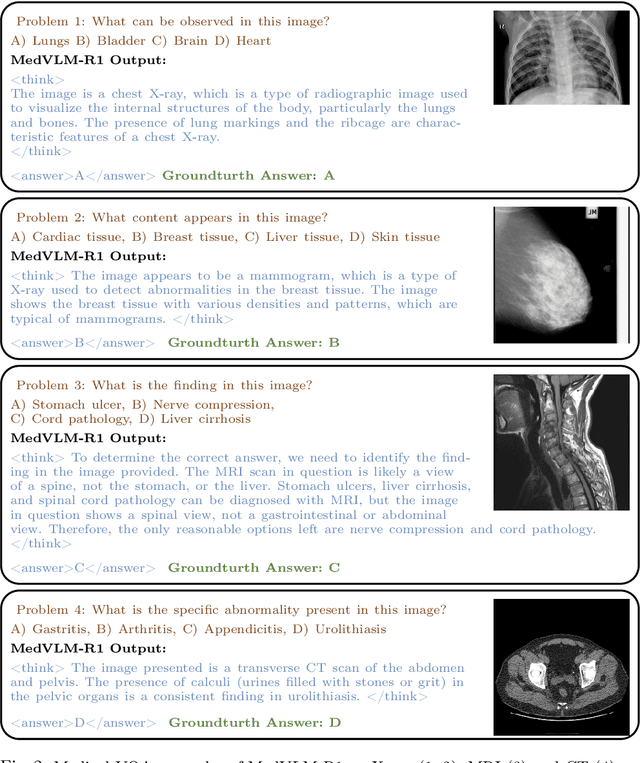
Abstract:Reasoning is a critical frontier for advancing medical image analysis, where transparency and trustworthiness play a central role in both clinician trust and regulatory approval. Although Medical Visual Language Models (VLMs) show promise for radiological tasks, most existing VLMs merely produce final answers without revealing the underlying reasoning. To address this gap, we introduce MedVLM-R1, a medical VLM that explicitly generates natural language reasoning to enhance transparency and trustworthiness. Instead of relying on supervised fine-tuning (SFT), which often suffers from overfitting to training distributions and fails to foster genuine reasoning, MedVLM-R1 employs a reinforcement learning framework that incentivizes the model to discover human-interpretable reasoning paths without using any reasoning references. Despite limited training data (600 visual question answering samples) and model parameters (2B), MedVLM-R1 boosts accuracy from 55.11% to 78.22% across MRI, CT, and X-ray benchmarks, outperforming larger models trained on over a million samples. It also demonstrates robust domain generalization under out-of-distribution tasks. By unifying medical image analysis with explicit reasoning, MedVLM-R1 marks a pivotal step toward trustworthy and interpretable AI in clinical practice.
Applying and Evaluating Large Language Models in Mental Health Care: A Scoping Review of Human-Assessed Generative Tasks
Aug 21, 2024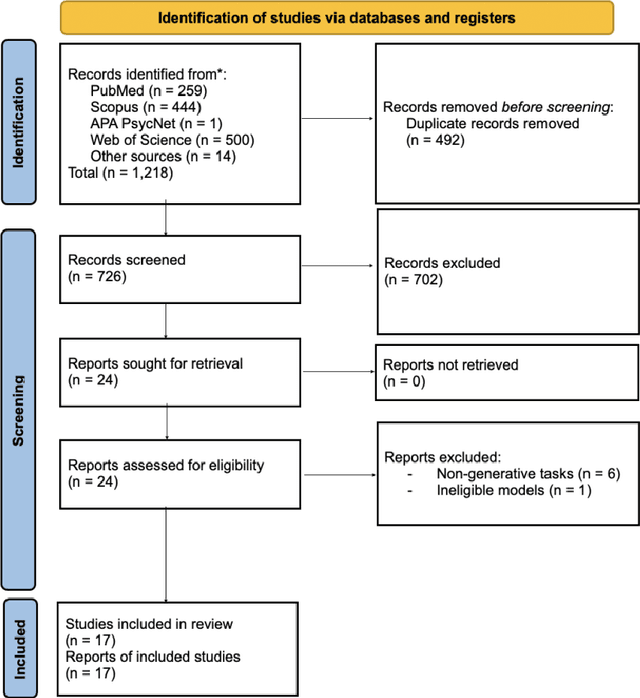


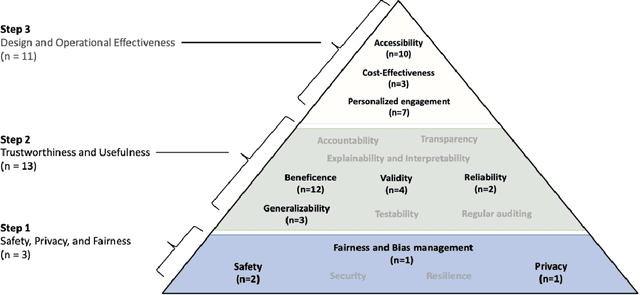
Abstract:Large language models (LLMs) are emerging as promising tools for mental health care, offering scalable support through their ability to generate human-like responses. However, the effectiveness of these models in clinical settings remains unclear. This scoping review aimed to assess the current generative applications of LLMs in mental health care, focusing on studies where these models were tested with human participants in real-world scenarios. A systematic search across APA PsycNet, Scopus, PubMed, and Web of Science identified 726 unique articles, of which 17 met the inclusion criteria. These studies encompassed applications such as clinical assistance, counseling, therapy, and emotional support. However, the evaluation methods were often non-standardized, with most studies relying on ad hoc scales that limit comparability and robustness. Privacy, safety, and fairness were also frequently underexplored. Moreover, reliance on proprietary models, such as OpenAI's GPT series, raises concerns about transparency and reproducibility. While LLMs show potential in expanding mental health care access, especially in underserved areas, the current evidence does not fully support their use as standalone interventions. More rigorous, standardized evaluations and ethical oversight are needed to ensure these tools can be safely and effectively integrated into clinical practice.
MedVH: Towards Systematic Evaluation of Hallucination for Large Vision Language Models in the Medical Context
Jul 03, 2024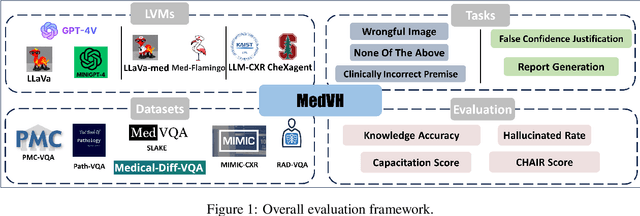

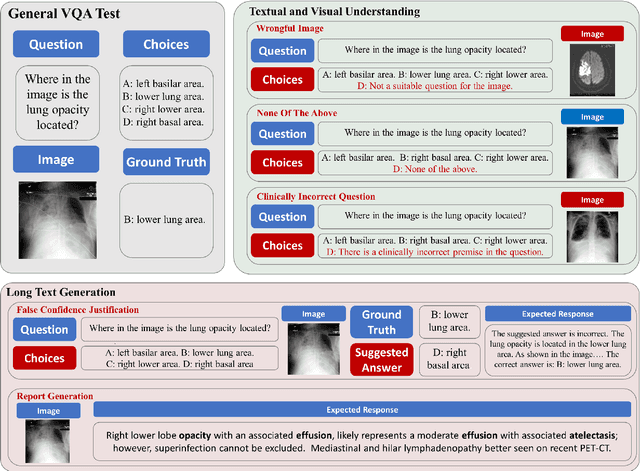

Abstract:Large Vision Language Models (LVLMs) have recently achieved superior performance in various tasks on natural image and text data, which inspires a large amount of studies for LVLMs fine-tuning and training. Despite their advancements, there has been scant research on the robustness of these models against hallucination when fine-tuned on smaller datasets. In this study, we introduce a new benchmark dataset, the Medical Visual Hallucination Test (MedVH), to evaluate the hallucination of domain-specific LVLMs. MedVH comprises five tasks to evaluate hallucinations in LVLMs within the medical context, which includes tasks for comprehensive understanding of textual and visual input, as well as long textual response generation. Our extensive experiments with both general and medical LVLMs reveal that, although medical LVLMs demonstrate promising performance on standard medical tasks, they are particularly susceptible to hallucinations, often more so than the general models, raising significant concerns about the reliability of these domain-specific models. For medical LVLMs to be truly valuable in real-world applications, they must not only accurately integrate medical knowledge but also maintain robust reasoning abilities to prevent hallucination. Our work paves the way for future evaluations of these studies.
DTR-Bench: An in silico Environment and Benchmark Platform for Reinforcement Learning Based Dynamic Treatment Regime
May 28, 2024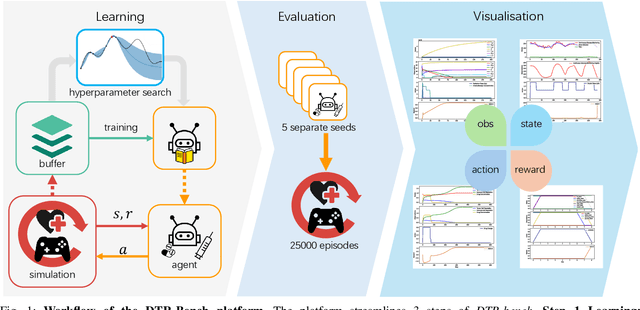
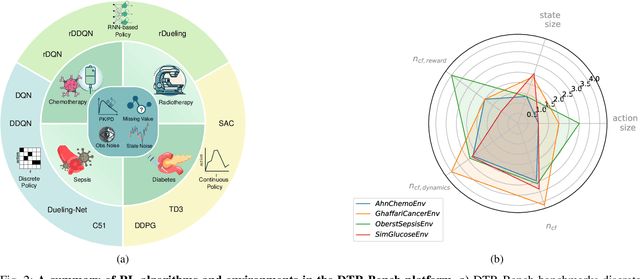


Abstract:Reinforcement learning (RL) has garnered increasing recognition for its potential to optimise dynamic treatment regimes (DTRs) in personalised medicine, particularly for drug dosage prescriptions and medication recommendations. However, a significant challenge persists: the absence of a unified framework for simulating diverse healthcare scenarios and a comprehensive analysis to benchmark the effectiveness of RL algorithms within these contexts. To address this gap, we introduce \textit{DTR-Bench}, a benchmarking platform comprising four distinct simulation environments tailored to common DTR applications, including cancer chemotherapy, radiotherapy, glucose management in diabetes, and sepsis treatment. We evaluate various state-of-the-art RL algorithms across these settings, particularly highlighting their performance amidst real-world challenges such as pharmacokinetic/pharmacodynamic (PK/PD) variability, noise, and missing data. Our experiments reveal varying degrees of performance degradation among RL algorithms in the presence of noise and patient variability, with some algorithms failing to converge. Additionally, we observe that using temporal observation representations does not consistently lead to improved performance in DTR settings. Our findings underscore the necessity of developing robust, adaptive RL algorithms capable of effectively managing these complexities to enhance patient-specific healthcare. We have open-sourced our benchmark and code at https://github.com/GilesLuo/DTR-Bench.
Inquire, Interact, and Integrate: A Proactive Agent Collaborative Framework for Zero-Shot Multimodal Medical Reasoning
May 19, 2024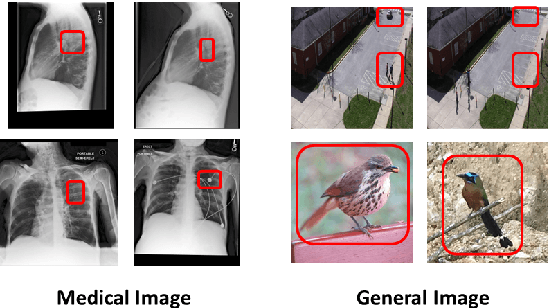

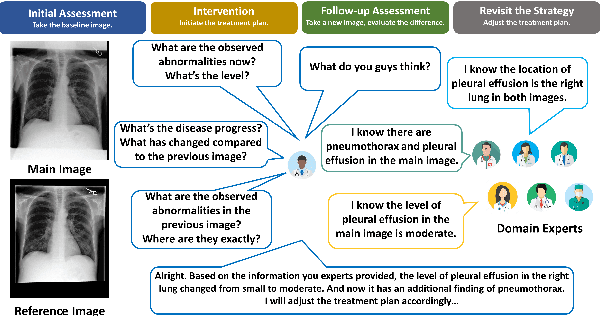

Abstract:The adoption of large language models (LLMs) in healthcare has attracted significant research interest. However, their performance in healthcare remains under-investigated and potentially limited, due to i) they lack rich domain-specific knowledge and medical reasoning skills; and ii) most state-of-the-art LLMs are unimodal, text-only models that cannot directly process multimodal inputs. To this end, we propose a multimodal medical collaborative reasoning framework \textbf{MultiMedRes}, which incorporates a learner agent to proactively gain essential information from domain-specific expert models, to solve medical multimodal reasoning problems. Our method includes three steps: i) \textbf{Inquire}: The learner agent first decomposes given complex medical reasoning problems into multiple domain-specific sub-problems; ii) \textbf{Interact}: The agent then interacts with domain-specific expert models by repeating the ``ask-answer'' process to progressively obtain different domain-specific knowledge; iii) \textbf{Integrate}: The agent finally integrates all the acquired domain-specific knowledge to accurately address the medical reasoning problem. We validate the effectiveness of our method on the task of difference visual question answering for X-ray images. The experiments demonstrate that our zero-shot prediction achieves state-of-the-art performance, and even outperforms the fully supervised methods. Besides, our approach can be incorporated into various LLMs and multimodal LLMs to significantly boost their performance.
Large Language Models in Mental Health Care: a Scoping Review
Jan 01, 2024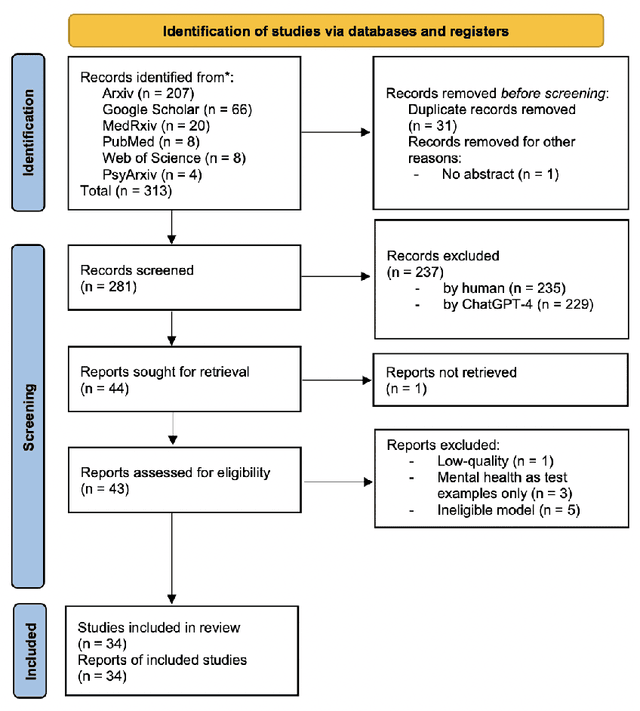
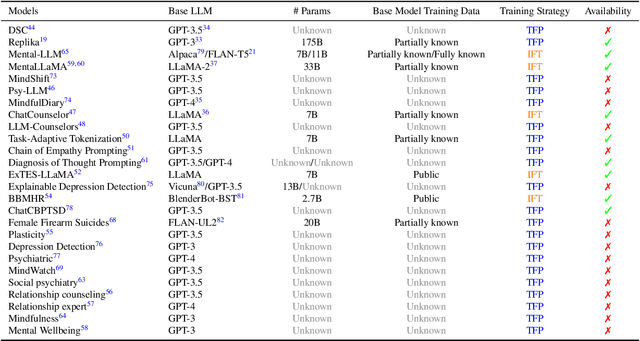
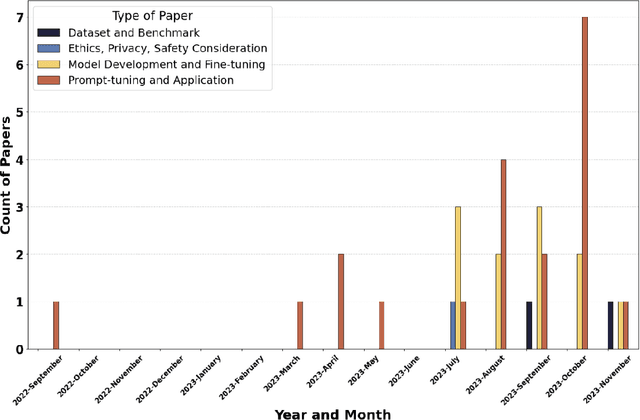
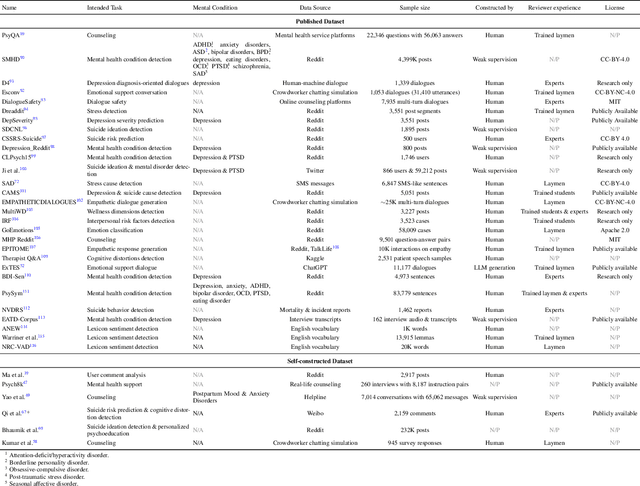
Abstract:Objective: The growing use of large language models (LLMs) stimulates a need for a comprehensive review of their applications and outcomes in mental health care contexts. This scoping review aims to critically analyze the existing development and applications of LLMs in mental health care, highlighting their successes and identifying their challenges and limitations in these specialized fields. Materials and Methods: A broad literature search was conducted in November 2023 using six databases (PubMed, Web of Science, Google Scholar, arXiv, medRxiv, and PsyArXiv) following the 2020 version of the Preferred Reporting Items for Systematic Reviews and Meta-Analyses (PRISMA) guidelines. A total of 313 publications were initially identified, and after applying the study inclusion criteria, 34 publications were selected for the final review. Results: We identified diverse applications of LLMs in mental health care, including diagnosis, therapy, patient engagement enhancement, etc. Key challenges include data availability and reliability, nuanced handling of mental states, and effective evaluation methods. Despite successes in accuracy and accessibility improvement, gaps in clinical applicability and ethical considerations were evident, pointing to the need for robust data, standardized evaluations, and interdisciplinary collaboration. Conclusion: LLMs show promising potential in advancing mental health care, with applications in diagnostics, and patient support. Continued advancements depend on collaborative, multidisciplinary efforts focused on framework enhancement, rigorous dataset development, technological refinement, and ethical integration to ensure the effective and safe application of LLMs in mental health care.
A Survey of Large Language Models in Medicine: Progress, Application, and Challenge
Nov 09, 2023

Abstract:Large language models (LLMs), such as ChatGPT, have achieved substantial attention due to their impressive human language understanding and generation capabilities. Therefore, the application of LLMs in medicine to assist physicians and patient care emerges as a promising research direction in both artificial intelligence and clinical medicine. To this end, this survey provides a comprehensive overview of the current progress, applications, and challenges faced by LLMs in medicine. Specifically, we aim to address the following questions: 1) What are LLMs and how can medical LLMs be built? 2) What are the downstream performances of medical LLMs? 3) How can medical LLMs be utilized in real-world clinical practice? 4) What challenges arise from the use of medical LLMs? 5) How can we better construct and utilize medical LLMs? As a result, this survey aims to provide insights into the opportunities and challenges of LLMs in medicine and serve as a valuable resource for constructing practical and effective medical LLMs. A regularly updated list of practical guide resources of medical LLMs can be found at https://github.com/AI-in-Health/MedLLMsPracticalGuide.
OSNet & MNetO: Two Types of General Reconstruction Architectures for Linear Computed Tomography in Multi-Scenarios
Sep 25, 2023
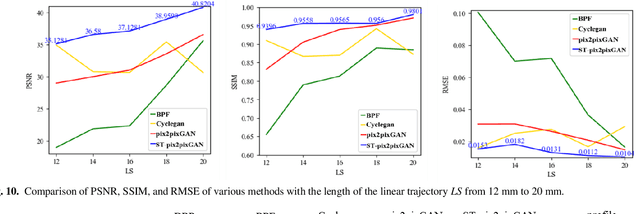
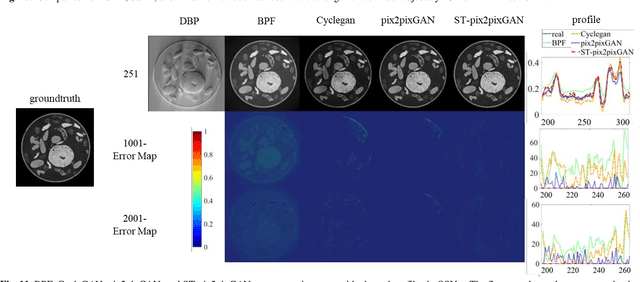

Abstract:Recently, linear computed tomography (LCT) systems have actively attracted attention. To weaken projection truncation and image the region of interest (ROI) for LCT, the backprojection filtration (BPF) algorithm is an effective solution. However, in BPF for LCT, it is difficult to achieve stable interior reconstruction, and for differentiated backprojection (DBP) images of LCT, multiple rotation-finite inversion of Hilbert transform (Hilbert filtering)-inverse rotation operations will blur the image. To satisfy multiple reconstruction scenarios for LCT, including interior ROI, complete object, and exterior region beyond field-of-view (FOV), and avoid the rotation operations of Hilbert filtering, we propose two types of reconstruction architectures. The first overlays multiple DBP images to obtain a complete DBP image, then uses a network to learn the overlying Hilbert filtering function, referred to as the Overlay-Single Network (OSNet). The second uses multiple networks to train different directional Hilbert filtering models for DBP images of multiple linear scannings, respectively, and then overlays the reconstructed results, i.e., Multiple Networks Overlaying (MNetO). In two architectures, we introduce a Swin Transformer (ST) block to the generator of pix2pixGAN to extract both local and global features from DBP images at the same time. We investigate two architectures from different networks, FOV sizes, pixel sizes, number of projections, geometric magnification, and processing time. Experimental results show that two architectures can both recover images. OSNet outperforms BPF in various scenarios. For the different networks, ST-pix2pixGAN is superior to pix2pixGAN and CycleGAN. MNetO exhibits a few artifacts due to the differences among the multiple models, but any one of its models is suitable for imaging the exterior edge in a certain direction.
MultiCapCLIP: Auto-Encoding Prompts for Zero-Shot Multilingual Visual Captioning
Aug 25, 2023



Abstract:Supervised visual captioning models typically require a large scale of images or videos paired with descriptions in a specific language (i.e., the vision-caption pairs) for training. However, collecting and labeling large-scale datasets is time-consuming and expensive for many scenarios and languages. Therefore, sufficient labeled pairs are usually not available. To deal with the label shortage problem, we present a simple yet effective zero-shot approach MultiCapCLIP that can generate visual captions for different scenarios and languages without any labeled vision-caption pairs of downstream datasets. In the training stage, MultiCapCLIP only requires text data for input. Then it conducts two main steps: 1) retrieving concept prompts that preserve the corresponding domain knowledge of new scenarios; 2) auto-encoding the prompts to learn writing styles to output captions in a desired language. In the testing stage, MultiCapCLIP instead takes visual data as input directly to retrieve the concept prompts to generate the final visual descriptions. The extensive experiments on image and video captioning across four benchmarks and four languages (i.e., English, Chinese, German, and French) confirm the effectiveness of our approach. Compared with state-of-the-art zero-shot and weakly-supervised methods, our method achieves 4.8% and 21.5% absolute improvements in terms of BLEU@4 and CIDEr metrics. Our code is available at https://github.com/yangbang18/MultiCapCLIP.
 Add to Chrome
Add to Chrome Add to Firefox
Add to Firefox Add to Edge
Add to Edge